This article is about Price Elasticity of Supply (PES).
It defines, calculates and interprets Price Elasticity of Supply (PES) as well as explains the factors that determine Price Elasticity of Supply (PES) and its impact on company revenue. The graphs illustrate various stages of Price Elasticity of Supply (PES).
What is Price Elasticity of Supply (PES)?
Price Elasticity of Supply (PES) measures how a change in price affects quantity supplied. Simply, how much supply of a product decreases or increases following an increase or decrease in the price of that product.
Price Elasticity of Supply (PES) also measures how quickly businesses respond to a change in price.
How to calculate Price Elasticity of Supply (PES)?
Price Elasticity of Supply (PES) is calculated using the following equation:
| %∆ Change in Quantity Supplied | |
| Price Elasticity of Supply (PES) = | ━━━━━━━━━━━━━━━━━━━━━━━━━━━━━━━━━━━━━━ |
| %∆ Change in Price |
Where:
| Final Value – Original Value | ||
| %∆ Change = | ━━━━━━━━━━━━━━━━━━━━━━━━━━━━━━ | x 100 |
| Original Value |
Different types of Price Elasticity of Supply (PES)
Price Elasticity of Supply (PES) is used to show the relationship that exists between the price of the product and the supply of this product.
It measures the responsiveness of supply of a product after a change in price.
Price Elasticity of Supply (PES) can be either:
- Perfectly inelastic
- Inelastic
- Unit elastic
- Elastic
- Perfectly elastic
The following descriptions of elasticities start from the situation when percentage change in price has completely no effect on quantity supplied until the situation when even a tiny change in price has a huge effect on quantity supplied.
1. Perfectly inelastic (PES = 0)
Value of Price Elasticity of Supply (PES) is 0. The product is to have perfectly inelastic supply. Supply does not react to change in price at all.
Comment: The percentage change in price of the product has no effect on the quantity supplied of that product. The same amount of product is supplied, no matter what the price is.
Examples of products: Some markets are unable to change the amount that they supply, for example visiting primary care physicians, events which sell tickets such as a concert or the goods in the market that are irreplaceable such as unique art – there is only one Mona Lisa.
How producers behave? Producers do not respond anyhow to a change in the price in this product.
Chart: The demand curve for perfectly inelastic products is vertical.
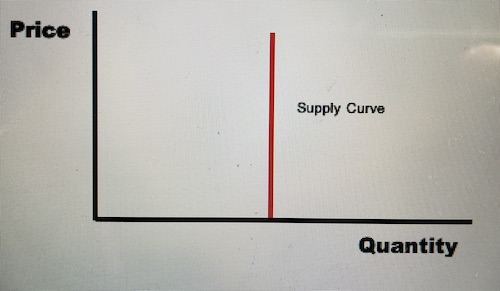
Calculations: The price of a product increased from USD$1,000 to USD$2,000 and supply did not change. What is the Price Elasticity of Supply (PES) for this product?
Step 1: Calculate the percentage change in Quantity Supplied.
%∆ Change in Quantity Demanded = 0%
Step 2: Calculate the percentage change in Price.
%∆ Change in Price = 100%
Step 3: Use the PES formula:
Price Elasticity of Supply (PES) = 0% / 100% = 0
It is now important to explain this result. A Price Elasticity of Supply (PES) of 0 means that supply changes by 0.0% for every 1.0% change in price.
What should the business do? If a firm faces this kind of elasticity of supply, it can raise the price indefinitely without losing any demand. This will increase the firm’s sales revenue. While a price reduction will reduce revenue because the supply will not change at all. In other words, the firm can charge any price for the products it produces.
2. Inelastic (0 < PES < 1)
Value of Price Elasticity of Supply (PES) is higher than 0 but lower than 1. The product is to have relatively inelastic supply. Supply does not react strongly to change in price.
Comment: The percentage change in price of the product has no effect on the quantity supplied of that product. The same amount of product is supplied, no matter what the price is.
Examples of products: Products that are not very responsive to changes in their price have price inelastic supply. This means that the percentage change in supply will be lower than the percentage change in price. For example, nuclear reactors as it takes a long time and unique expertise to build a new nuclear reactor. In case the demand increases rapidly, only a few firms in the world would be able to increase output quickly. Another example are fruits and vegetables which take many months to grow and rape for harvest which usually happens once or twice a year.
How producers behave? Producers do not respond greatly to a change in the price of the product.
Chart: Firms are unable to react quickly to price changes. This will result in the curve being to the right of the origin.
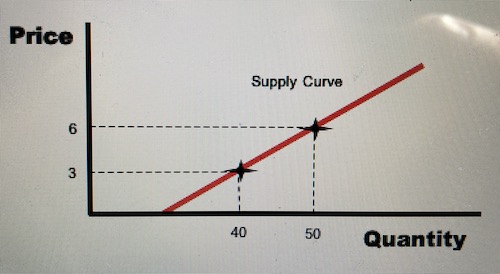
Calculations: The price of a product increased from USD$3 to USD$6 and demand changed from 40 units to 50 units. What is the Price Elasticity of Supply (PES) for this product?
Step 1: Calculate the percentage change in Quantity Supplied.
%∆ Change in Quantity Demanded = 25%
Step 2: Calculate the percentage change in Price.
%∆ Change in Price = 100%
Step 3: Use the PES formula:
Price Elasticity of Supply (PES) = 25% / 100% = 0.25
It is now important to explain this result. A Price Elasticity of Supply (PES) of 0.25 means that supply changes by 0.25% for every 1.0% change in price. The supply changes less than price.
What should the business do? If a firm faces this kind of elasticity of supply, it has limits in increasing its quantity supplied to the market. While prices keep growing, the firm is only able to increase its production by a little bit to catch the demand. But, this is still proportionally less than price increases.
3. Unit elastic (PES = 1)
Value of Price Elasticity of Supply (PES) is 1. The product is to have a unit elasticity of supply or unitary elasticity of supply.
Comment: The percentage change in price of the product is the same as the percentage change in supply of that product. The percentage change in supply is equal and opposite to the percentage change in price.
Examples of products: In reality, a unitary elastic product will maintain a certain level of income regardless of price. For instance, when the price is USD$1 then the supply will be 100 units, hence sales revenue will be USD$100. While when the price is USD$100 then the supply will be 1, hence sales revenue will also be USD$100.
How producers behave? Any price change will lead to an equal change in supply and the total sales revenue will remain constant. Producers respond proportionally to a change in the price in this product.
Chart: The supply curve for unit elastic products has a traditional supply curve shape. If Price Elasticity of Supply (PES) is 1, supply is unit elastic and results in the curve starting at the origin (point 0).
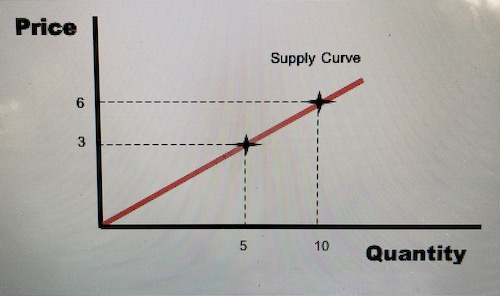
Calculations: The price of a product increased from USD$3 to USD$6 and supply of the product increased from 5 to 10 units. What is the Price Elasticity of Supply (PES) for this product?
Step 1: Calculate the percentage change in Quantity Supplied.
%∆ Change in Quantity Demanded = 100%
Step 2: Calculate the percentage change in Price.
%∆ Change in Price = 100%
Step 3: Use the PES formula:
Price Elasticity of Supply (PES) = 100% / 100% = 1
It is now important to explain this result. A Price Elasticity of Supply (PES) of 1 means that supply changes by 1.0% for every 1.0% change in price. The supply changes the same as the price.
What should the business do? If a firm faces this kind of elasticity of supply, it deals with proportional changes in output supplied and prices. It can either supply more as prices grow, or supply less as prices decline without. The quantity supplied will be changing by the same proportion as the price.
4. Elastic (1 < PES < ∞)
Value of Price Elasticity of Supply (PES) is higher than 1. The product is to have relatively elastic supply. Supply reacts strongly to change in price.
Comment: The percentage change in price of the product has strong effect on its supply. The percentage change in supply is greater than the percentage change in price. The supply of elastic goods and services is more responsive to price changes than others.
Examples of products: Products that are more responsive to changes in their price have price elastic supply. This means that the percentage change in supply will be larger than the percentage change in price. This is very common for products that are easy to produce and do not require much input or complicated machinery. For example, TAXI services as it is relatively easy for many drivers who own a car and a valid driving licence to become a TAXI driver.
How producers behave? Producers respond greatly to a change in the price of the product.
Chart: Companies are able to react quickly to a change in price. This will result in the curve starting above the origin (point 0).
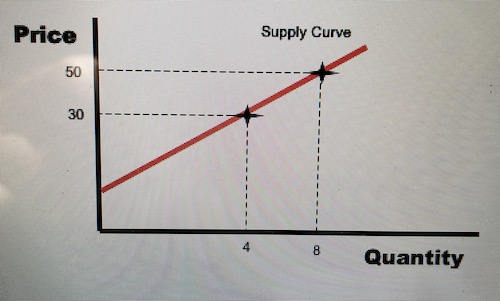
Calculations: The price of a product increased from USD$30 to USD$50 and supply changed from 40 units to 80 units. What is the Price Elasticity of Supply (PES) for this product?
Step 1: Calculate the percentage change in Quantity Supplied.
%∆ Change in Quantity Supplied = 100%
Step 2: Calculate the percentage change in Price.
%∆ Change in Price = 66.67%
Step 3: Use the PES formula:
Price Elasticity of Supply (PES) = 100% / 66.67% = 1.5
It is now important to explain this result. A Price Elasticity of Supply (PES) of 1.5 means that supply changes by 1.5% for every 1.0% change in price. The supply changes more than the price.
What should the business do? If a firm faces this kind of elasticity of supply, it does not have limits in increasing its quantity supplied to the market. While prices keep growing, the firm is able to increase its production by much more to catch the demand. The quantity supplied changes by a greater proportion than the price change.
5. Perfectly elastic (PES = ∞)
Value of Price Elasticity of Supply (PES) is infinite. The product is to have perfectly elastic supply. Supply does react even to a slight change in price – any change in price will see the supply provided fall to zero.
Comment: The percentage change in price of the product has extreme effect on the quantity supplied of that product. Producers are prepared to supply any quantity required to the market, but only for a limited price. An infinitely large amount is supplied at one price, but when the price is raised even by the smallest amount, then supply falls to zero as no producer is willing to supply at a different price.
Examples of products: In reality, there are no products that would have this kind of Price Elasticity of Demand (PED). It is because no business will ever supply infinite number of products (any quantity) because nobody has infinite resources. However, the closest example could perhaps be many governments providing compulsory primary school education for all no matter how many children are there in the society that need schooling.
How producers behave? Producers respond in an extreme way to even a slightest change in the price in this product.
Chart: The supply curve for perfectly inelastic products is horizontal.
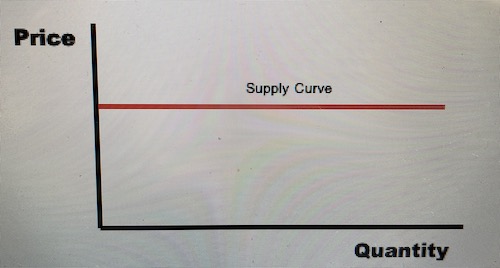
Calculations: The price of a product did not change, but demand increased from 10,000 to 20,000. What is the Price Elasticity of Supply (PES) for this product?
Step 1: Calculate the percentage change in Quantity Supplied.
%∆ Change in Quantity Supplied = 100%
Step 2: Calculate the percentage change in Price.
%∆ Change in Price = 0%
Step 3: Use the PES formula:
Price Elasticity of Supply (PES) = 100% / 0% = ∞
It is now important to explain this result. A Price Elasticity of Supply (PES) of ∞ means that supply is ∞ only at the certain price. Supply will drop to 0 for any change in price.
What should the business do? If a firm faces this kind of elasticity of demand, it should supply an endless number of products indefinitely, but only at the certain price. Selling at the same price and producing indefinite number of products will increase the firm’s sales revenue. Selling at any other price will reduce revenue to zero because the supply will change to zero. It will not make sense for a business to produce at any other price.
Price Elasticity of Supply (PES) and Sales Revenue
Let’s see how to apply Price Elasticity of Supply (PES) into real business situations to help the business increase sales.
Understanding Price Elasticity of Supply (PES) is important when making production decisions. It informs whether producers can react fully to price changes and how fast. This will cause either gain in sales revenue or missing on potential sales.
- When supply is perfectly elastic, producers are able to supply any quantity required to the market. This will boost their sales revenue by increasing quantity as price remains the same.
- When supply is elastic, companies are able to react quickly to a change in price. This will boost their sales revenue by increasing quantity when the price increases as well.
- When supply is inelastic, firms are not able to react quickly to a change in price. This will result in lost sales revenue caused by delayed supply.
- When supply is perfectly inelastic, companies are not able to change the amount that they supply. In order to maximize sales revenue, the company will need to boost the price as quantity remains the same.
In the short-term, suppliers cannot react fully to price changes. There is a delay in production or lag in manufacturing. Over a longer period of time the elasticity is influenced by many factors.
Factors that affects Price Elasticity of Supply (PES)
There are many influences on Price Elasticity of Supply (PES):
- Time. The price elasticity of supply is greater when the length of time under consideration is longer. It is because over a longer period of time producers have more options for adjusting to the change in price. Also, manufacturers need more time to adjust their input used in the production process.
- Length of production period. Companies that can quickly adjust its production process and produce more output will have higher price elasticity of supply. On the contrary, companies that are slow with adjusting its production process will have a relatively inelastic supply as it takes long time and effort to adjust the production process to change the supply.
- Ease of entry into the market / Exit from the market. If companies find it difficult to enter or leave the industry, it will cause the supply curve to become relatively inelastic. Under these circumstances, it will be difficult to set up production fast. When companies find it easy to enter or leave the industry, it will cause the supply curve to become relatively elastic. Under these circumstances, it will be easy to set up production fast.
- Spare capacity. This is about how much spare capacity the business has including free space to stock more inventory, unused machinery, additional workers, etc. When the firm has plenty of spare capacity, it could use it to produce more output quickly, therefore supply will be relatively elastic. The firm can easily adjust its quantity supplied to the price change. On another hand, when the firm does not have much spare capacity, it is harder to produce more output quickly, therefore supply will be relatively inelastic. The firm cannot easily adjust its quantity supplied to the price change.
- Ability to keep additional inventories. This is about stocks of raw materials, components, semi-finished goods and finished goods. When a business can keep inventories for a long period of time, it can swiftly respond to a change in demand by supplying product to the market to respond to the price quicker. However, when a business cannot keep inventories for a long period of time, it is not able to respond to a change in demand fast enough.
- Flexibility of resources. Also, when capital and workforce can be used for other things, then the elasticity of supply for a good or survive is likely to be high. For example, a juice bottling company may be able to use the machinery for bottled water or any other type of soft drink. However, if the firm doesn’t have such flexibility with current resources, it might face high cost of acquiring them within a short time, hence it has a more inelastic supply curve.
Summary
Price Elasticity of Supply (PES) looks at how change in the price of the product affects the supply of this product.
It is important as companies react to changes in price differently. Additionally, their ability to alter their supplies of product to markets is affected by many different factors which depend not only upon their own situation, but also upon the market they operate in.
 Articles: 1,400 · Readers: 740,000 · Views: 2,209,961
Articles: 1,400 · Readers: 740,000 · Views: 2,209,961 